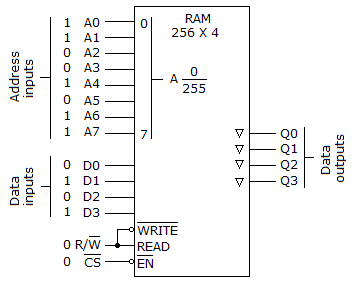Discussion
Home ‣ Digital Electronics ‣ Memory and Storage Comments
- Question
What is the significance of the inverted triangles on the outputs of the device in the given figure?

Options- A. They represent inverters and mean that the outputs are active-LOW.
- B. They represent buffers and mean that the outputs can drive 40 TTL loads, instead of the normal 10.
- C. It means that the outputs will be active only if a change has occurred at that memory location since the last read/write cycle.
- D. The outputs are tristated.
- Correct Answer
- The outputs are tristated.
- 1. The ideal memory ________.
Options- A. has high storage capacity
- B. is nonvolatile
- C. has in-system read and write capacity
- D. has all of the above characteristics Discuss
- 2. In general, the ________ have the smallest bit size and the ________ have the largest.
Options- A. EEPROMs, Flash
- B. SRAM, mask ROM
- C. mask ROM, SRAM
- D. DRAM, PROM Discuss
- 3. The main advantage of semiconductor RAM is its ability to:
Options- A. retain stored data when power is interrupted or turned off
- B. be written to and read from rapidly
- C. be randomly accessed
- D. be sequentially accessed Discuss
- 4. Which of the following RAM timing parameters determine its operating speed?
Options- A. tACC
- B. tAA and tACS
- C. tCO and tOD
- D. tRC and tWC Discuss
- 5. Describe the timing diagram of a write operation.
Options- A. First the data is set on the data bus and the address is set, then the write pulse stores the data.
- B. First the address is set, then the data is set on the data bus, and finally the read pulse stores the data.
- C. First the write pulse stores the data, then the address is set, and finally the data is set on the data bus.
- D. First the data is set on the data bus, then the write pulse stores the data, and finally the address is set. Discuss
- 6. Which of the following describes the action of storing a bit of data in a mask ROM?
Options- A. A 1 is stored in a bipolar cell by opening the base connection to the address line.
- B. A 0 is stored in a bipolar cell by shorting the base connection to the address line.
- C. A 1 is stored by connecting the gate of a MOS cell to the address line.
- D. A 0 is stored by connecting the gate of a MOS cell to the address line. Discuss
- 7. What is the difference between static RAM and dynamic RAM?
Options- A. Static RAM must be refreshed, dynamic RAM does not.
- B. There is no difference.
- C. Dynamic RAM must be refreshed, static RAM does not. Discuss
- 8. An 8-bit address code can select ________.
Options- A. 8 locations in memory
- B. 256 locations in memory
- C. 65,536 locations in memory
- D. 131,072 locations in memory Discuss
- 9. Which type of ROM has to be custom built by the factory?
Options- A. ROM
- B. mask ROM
- C. EPROM
- D. EEPROM Discuss
- 10. Which of the following is one of the basic characteristics of DRAMs?
Options- A. DRAMs must have a constantly changing input.
- B. DRAMs must be periodically refreshed in order to be able to retain data.
- C. DRAMs have a broader "dynamic" storage range than other types of memories.
- D. DRAMs are simpler devices than other types of memories. Discuss
Memory and Storage problems
Search Results
Correct Answer: has all of the above characteristics
Correct Answer: EEPROMs, Flash
Correct Answer: be written to and read from rapidly
Correct Answer: tRC and tWC
Correct Answer: First the data is set on the data bus and the address is set, then the write pulse stores the data.
Correct Answer: A 1 is stored by connecting the gate of a MOS cell to the address line.
Correct Answer: Dynamic RAM must be refreshed, static RAM does not.
Correct Answer: 256 locations in memory
Correct Answer: mask ROM
Correct Answer: DRAMs must be periodically refreshed in order to be able to retain data.
Comments
There are no comments.More in Digital Electronics:
Programming
Copyright ©CuriousTab. All rights reserved.
